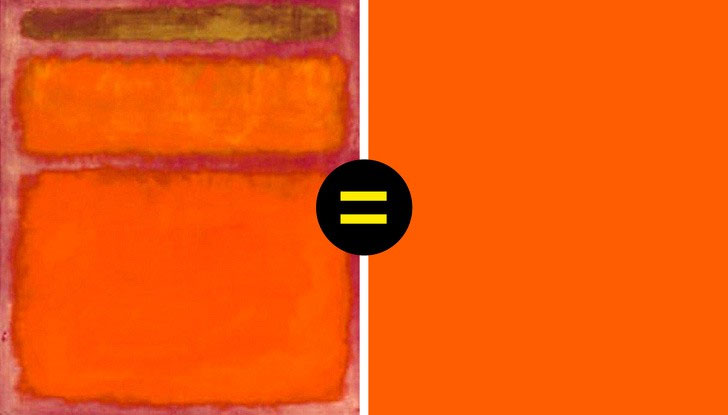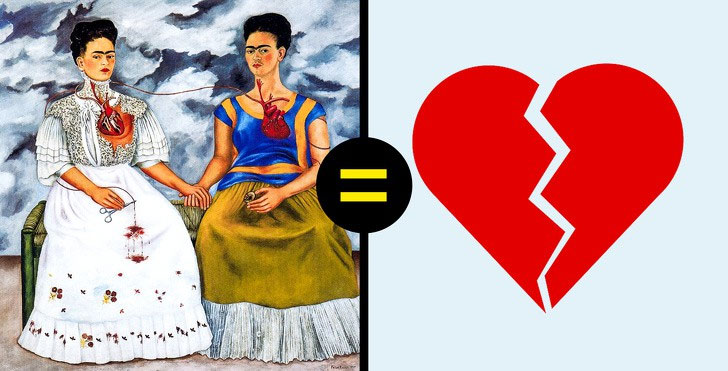The true meaning of world famous paintings that most of us do not know
You know, behind every painting there is a story, especially with painting masterpieces that can be sold for millions of dollars. But like literature, painting is also a very abstract field. Sometimes we look at a painting, feel and analyze many ideas, but the author's real intentions are not the same.
So try the famous pictures below, what is the artist's true intention.
1. "Orange, Red, Yellow" - Mark Rothko, 1961

Orange, Red, Yellow (Orange, Red, Yellow) is the work of American painter Mark Rothko. In 2012, this work was put up for auction and collected huge amounts of up to 86 million USD.
But what does this painting mean? In fact, according to experts, we do not necessarily need to find any message in it. What viewers need to pay attention to is the feeling of looking at the painting. Rothko's goal is to want viewers to experience all emotions when looking at the color depth in it.
Is it difficult to understand? It's okay, because no matter what painting is a abstract subject.
2. "Two Frida" - Frida Kahlo, 1939

Two Frida (Two Fridas) is a self-portrait work by Frida Kahlo - the most famous portrait painter in Mexico in the 20th century. It is just a bit . strange, when she drew up to two beings in it.
Experts have put forward many theories about the author's idea, but the most popular is Kahlo wants to describe the event she broke up with her husband, Diego Rivera. The painting was completed in 1939, shortly after the divorce.
In the picture is 2 Frida with 2 different images. On the right is a Frida Diego who has devoted everything to love, and on the left is a betrayed Frida. Kahlo wants to show the difference between its two selves, and shows loneliness, as well as the heart has broken without any healing.
3. "Man and woman in front of a pile of manure" - Joan Miró, 1935

This is one of the 12 most famous paintings of the Catalan painter - Joan Miró, performed during the Spanish civil war. A picture shows the ghost, with the contrast between the dancing person and the deadly black background behind.
The painter's intentions are not too difficult to understand: He wanted to describe the terror of the Spanish Civil War (1936 - 1939). The dark orange patches represent the victims of the war, and the red hands show the bloody streak.
4. "Walk" - Marc Chagall, 1917–1918

"Walk" - "Walk" is one of Chagall's most famous works. The analysis shows that this is a self-portrait, so the two people in the picture are Chagall and his wife Bella.
In the picture, Chagall stands on the ground, while Bella floats in the sky, but they still hold hands tightly. It is the love they have for each other, transcending the distance and common physical laws.
5. 3 periods of women - Gustav Klimt, 1905

The " Three Ages of Woman" is one of the most famous works of the Austrian artist, completed in 1911 and won a gold medal in an international exhibition in Rome. .
The painting is the best example of Klimt's abstract style. On the right is a little girl lying in the middle of a woman's hand, and on the left is an old lady trying to hide her face.
The more you look at this picture, the more you will understand that it does not draw 3 generations of a family, but the same woman in 3 different stages of a human life.
6. "Where are we from? What are we? Where are we going?" - Paul Gauguin, 1897–1898

Since the beginning of his career, Paul Gauguin has always wanted to show his thinking about life and death through his works. In 1897, he painted the book "Where are we from? What are we? Where are we going?" (Where Do We Come From? What Are We Where Are We Going?), And it took a year to complete.
In order to understand the meaning of this painting, we need to keep track from right to left, as it is expressed in ancient ancient scrolls. In the picture are 3 groups of people: a young woman and a sleeping newborn baby symbolizing the origin of life; The next group represents the existence of humanity at a young age; and finally the old woman lying down, showing the final moment of life.
7. "Night cafe" - Vincent van Gogh, 1888

When I first observed it, perhaps no one noticed this unusual painting. But for Jared Baxter, a painting researcher, this picture may be another version of "The Last Meal" - author Leonardo da Vinci.
If you look closely, we will see the waiter in white clothes standing in the middle. He was surrounded by 12 people, and the cross was shining on the background.
- Strange secret hidden behind 7 'haunted' paintings
- 5 extremely unknown secrets behind the paintings of genius Leonardo da Vinci
- The true meaning lies behind famous logos
- Message mystery is hidden in famous ancient paintings
- 14 famous symbols but few people understand the meaning (Part 2)
- The mysteries are hidden in famous paintings
- Not only artistic value, these 6 paintings also reveal incredible facts about the old world
- Top 5 German Nazi secrets have been discovered
- Marvel at 15 beautiful paintings as much as photos
- The ghost picture haunts thousands of people
- Surprise with the true appearance of famous historical figures
- Beautiful mosaic in the ancient city
- Surprise the world's oldest painting discovered in cave ... Indonesia
- Animals always 'discharge themselves for great meaning'
 'Fine laughs' - Scary and painful torture in ancient times
'Fine laughs' - Scary and painful torture in ancient times The sequence of numbers 142857 of the Egyptian pyramids is known as the strangest number in the world - Why?
The sequence of numbers 142857 of the Egyptian pyramids is known as the strangest number in the world - Why? History of the iron
History of the iron What is alum?
What is alum?